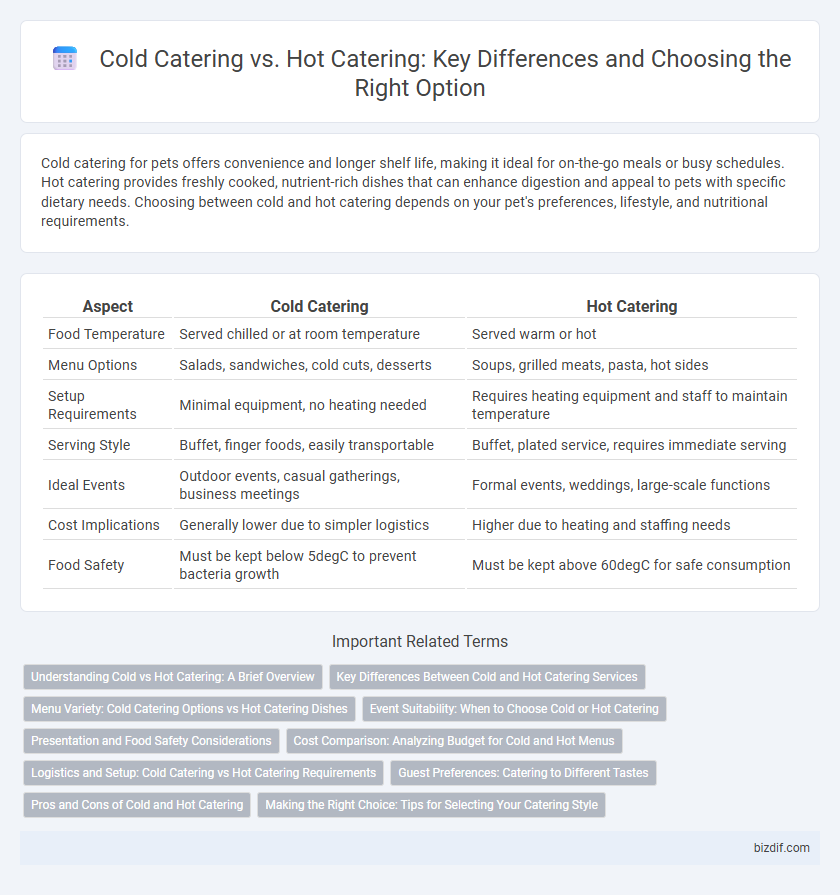Cold catering for pets offers convenience and longer shelf life, making it ideal for on-the-go meals or busy schedules. Hot catering provides freshly cooked, nutrient-rich dishes that can enhance digestion and appeal to pets with specific dietary needs. Choosing between cold and hot catering depends on your pet's preferences, lifestyle, and nutritional requirements.
Table of Comparison
| Aspect | Cold Catering | Hot Catering |
|---|---|---|
| Food Temperature | Served chilled or at room temperature | Served warm or hot |
| Menu Options | Salads, sandwiches, cold cuts, desserts | Soups, grilled meats, pasta, hot sides |
| Setup Requirements | Minimal equipment, no heating needed | Requires heating equipment and staff to maintain temperature |
| Serving Style | Buffet, finger foods, easily transportable | Buffet, plated service, requires immediate serving |
| Ideal Events | Outdoor events, casual gatherings, business meetings | Formal events, weddings, large-scale functions |
| Cost Implications | Generally lower due to simpler logistics | Higher due to heating and staffing needs |
| Food Safety | Must be kept below 5degC to prevent bacteria growth | Must be kept above 60degC for safe consumption |
Understanding Cold vs Hot Catering: A Brief Overview
Cold catering offers versatile, easy-to-serve dishes such as sandwiches, salads, and sushi that maintain freshness without reheating, making it ideal for outdoor events or buffets. Hot catering involves freshly cooked meals like roasted meats, pasta, and casseroles, delivered at optimal temperatures for immediate consumption, perfect for formal dinners and sit-down meals. Choosing between cold and hot catering depends on factors such as event type, menu preferences, and logistical considerations like equipment for heating food.
Key Differences Between Cold and Hot Catering Services
Cold catering involves serving pre-prepared dishes that are typically chilled or served at room temperature, such as salads, sandwiches, and cold appetizers, making it ideal for quick setup and outdoor events. Hot catering requires on-site heating or cooking to serve warm meals like soups, roasts, and grilled items, ensuring freshly cooked food with enhanced flavors and presentation. Key differences include temperature control, equipment needs, and menu variety, with hot catering often demanding more logistical planning and resources than cold catering.
Menu Variety: Cold Catering Options vs Hot Catering Dishes
Cold catering offers a diverse menu featuring salads, sandwiches, charcuterie boards, and fresh fruit platters, ideal for events requiring easy-to-serve and visually appealing options. Hot catering dishes include roasted meats, pasta, soups, and baked entrees, providing warm, hearty meals suitable for formal dinners or large gatherings. Choosing between cold and hot catering depends on event type, dietary preferences, and desired service style, with cold catering excelling in convenience and variety, while hot catering emphasizes comfort and richness.
Event Suitability: When to Choose Cold or Hot Catering
Cold catering is ideal for networking events, outdoor gatherings, and occasions requiring easy self-service with minimal equipment, as it offers convenience and a wide variety of ready-to-eat options like sandwiches, salads, and charcuterie. Hot catering suits formal dinners, corporate banquets, and events where freshly prepared, warm meals such as carved meats, pasta, and cooked vegetables enhance guest experience. Choosing between cold and hot catering depends on factors like event duration, venue facilities, guest preferences, and the desired level of service sophistication.
Presentation and Food Safety Considerations
Cold catering offers visually appealing, artfully arranged dishes that maintain freshness and vibrant colors, enhancing presentation quality. Hot catering requires insulated containers and precise temperature control to ensure food safety by preventing bacterial growth while preserving taste and texture. Both options demand strict adherence to hygiene standards, but cold catering emphasizes chilled storage, whereas hot catering focuses on consistent heat maintenance.
Cost Comparison: Analyzing Budget for Cold and Hot Menus
Cold catering generally offers lower costs due to reduced energy consumption and simpler food preparation, making it ideal for budget-conscious events. Hot catering entails higher expenses from equipment, staffing, and temperature control, significantly impacting overall event budgets. Careful analysis of menu options and service requirements helps optimize costs while ensuring guest satisfaction.
Logistics and Setup: Cold Catering vs Hot Catering Requirements
Cold catering requires simpler logistics with minimal reheating equipment and less stringent temperature control during transport, often relying on insulated containers to maintain freshness. Hot catering demands more complex setup including portable heating units, steam tables, and continuous temperature monitoring to ensure food safety and optimal serving temperatures. Efficient hot catering logistics must address power supply needs and timing coordination to prevent food spoilage and ensure timely service.
Guest Preferences: Catering to Different Tastes
Cold catering offers a refreshing selection of salads, sandwiches, and finger foods ideal for guests who prefer lighter, easily portable meals. Hot catering provides warm, hearty dishes such as carved meats, pasta, and cooked vegetables that appeal to those seeking comfort and indulgence. Understanding guest preferences ensures a balanced menu that accommodates diverse tastes and dietary needs.
Pros and Cons of Cold and Hot Catering
Cold catering offers convenience and ease of transport, making it ideal for outdoor events and large gatherings, but it may lack the warmth and appeal of freshly cooked food. Hot catering provides freshly prepared meals that enhance flavor and presentation, yet requires specialized equipment and careful timing to maintain temperature and quality. Choosing between cold and hot catering depends on factors like event type, menu preferences, and logistical considerations.
Making the Right Choice: Tips for Selecting Your Catering Style
Cold catering offers convenience and freshness, ideal for events requiring easy serving and minimal onsite preparation, featuring items like salads, sandwiches, and charcuterie. Hot catering suits formal or celebratory occasions needing warm, rich dishes such as pasta, roast meats, and steamed vegetables, ensuring a satisfying and hearty meal experience. Consider event type, guest preferences, and logistics when selecting the right catering style to maximize satisfaction and operational efficiency.
Cold catering vs hot catering Infographic

 bizdif.com
bizdif.com